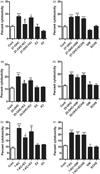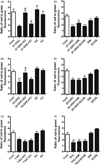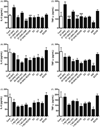Differential effects of the estrogen receptor agonist estradiol on toxicity induced by enzymatically-derived or autoxidation-derived oxysterols in human ARPE-19 cells
- PMID: 23841471
- PMCID: PMC4067899
- DOI: 10.3109/02713683.2013.811257
Differential effects of the estrogen receptor agonist estradiol on toxicity induced by enzymatically-derived or autoxidation-derived oxysterols in human ARPE-19 cells
Abstract
Purpose/aim of the study: Disturbances in cholesterol metabolism and increased levels of cholesterol oxidation products (oxysterols) in retina may contribute to age-related macular degeneration (AMD). The role of oxysterols or of their target receptors liver X receptors (LXRs) and estrogen receptors (ERs) in the pathogenesis of MD is ill-known. The purpose of this study is to determine the extent to which the oxysterols 27-hydroxycholesterol (27-OHC), 25-hydroxycholesterol (25-OHC) and 7-ketocholesterol (7-KC) affect the transcriptional activity of LXR and ER.
Materials and methods: ARPE-19 cells, untreated or incubated with 27-OHC, 25-OHC or 7-KC for 24 h were harvested. We used Western blot analyses for detecting ERs and LXRs expression, dual luciferase assays for measuring LXRs and ERs transcriptional activity, cytotox-ONE homogeneous membrane integrity assay for measuring cytotoxicity, JC-1 method for measuring mitochondrial membrane potential changes and ELISA for measuring cytokine levels.
Results: Both LXRs and ERs are expressed and are transcriptionally active in ARPE-19 cells. 27-OHC, 25-OHC and 7-KC inhibited ER-mediated transcriptional activity, whereas 27-OHC and 25-OHC increased LXR-mediated transcription. E2 reduced 25-OHC and 27-OHC-induced cytotoxicity, mitochondrial permeability potential decline, and cytokine secretion. The LXR agonist GW3965 or the LXR antagonist 5α-6α-epoxycholesterol-3-sulfate (ECHS) did not offer protection against either 27-OHC and 25-OHC or 7-KC.
Conclusions: Increased levels of oxysterols can decrease ER and increase LXR signaling. ER agonists can offer protection against cytotoxic effects of 27-OHC and 25-OHC, two oxysterols derived by enzymatic reactions. Although they exert similar toxicity, the cellular mechanisms involved in the toxic effects of oxysterols whether derived by enzymatic or autoxidation reactions appear to be different.
Conflict of interest statement
The authors report no conflicts of interest. The authors alone are responsible for the content and writing of this article.
Figures





Similar articles
-
The oxysterol 27-hydroxycholesterol regulates α-synuclein and tyrosine hydroxylase expression levels in human neuroblastoma cells through modulation of liver X receptors and estrogen receptors--relevance to Parkinson's disease.J Neurochem. 2011 Dec;119(5):1119-36. doi: 10.1111/j.1471-4159.2011.07497.x. Epub 2011 Oct 24. J Neurochem. 2011. Retraction in: J Neurochem. 2025 Jan;169(1):e16240. doi: 10.1111/jnc.16240. PMID: 21951066 Free PMC article. Retracted.
-
LXR-activating oxysterols induce the expression of inflammatory markers in endothelial cells through LXR-independent mechanisms.Atherosclerosis. 2009 Nov;207(1):38-44. doi: 10.1016/j.atherosclerosis.2009.04.001. Epub 2009 Apr 11. Atherosclerosis. 2009. PMID: 19426978
-
The oxysterol 27-hydroxycholesterol increases β-amyloid and oxidative stress in retinal pigment epithelial cells.BMC Ophthalmol. 2010 Sep 13;10:22. doi: 10.1186/1471-2415-10-22. BMC Ophthalmol. 2010. PMID: 20836858 Free PMC article.
-
Pathophysiological role of 27-hydroxycholesterol in human diseases.Adv Biol Regul. 2022 Jan;83:100837. doi: 10.1016/j.jbior.2021.100837. Epub 2021 Nov 7. Adv Biol Regul. 2022. PMID: 34774482 Review.
-
Diverse functions of 24(S)-hydroxycholesterol in the brain.Biochem Biophys Res Commun. 2014 Apr 11;446(3):692-6. doi: 10.1016/j.bbrc.2014.02.010. Epub 2014 Feb 12. Biochem Biophys Res Commun. 2014. PMID: 24530911 Review.
Cited by
-
Coronary Microvascular Dysfunction is Associated with Augmented Lysosomal Signaling in Hypercholesterolemic Mice.bioRxiv [Preprint]. 2024 Jul 12:2024.07.10.603000. doi: 10.1101/2024.07.10.603000. bioRxiv. 2024. Update in: J Am Heart Assoc. 2024 Dec 3;13(23):e037460. doi: 10.1161/JAHA.124.037460. PMID: 39026774 Free PMC article. Updated. Preprint.
-
Impact of Oxysterols in Age-Related Disorders and Strategies to Alleviate Adverse Effects.Adv Exp Med Biol. 2024;1440:163-191. doi: 10.1007/978-3-031-43883-7_9. Adv Exp Med Biol. 2024. PMID: 38036880 Review.
-
Inhibition of Candida albicans biofilm by pure selenium nanoparticles synthesized by pulsed laser ablation in liquids.Nanomedicine. 2017 Apr;13(3):1095-1103. doi: 10.1016/j.nano.2016.10.011. Epub 2016 Oct 25. Nanomedicine. 2017. PMID: 27793789 Free PMC article.
-
Coronary Microvascular Dysfunction Is Associated With Augmented Lysosomal Signaling in Hypercholesterolemic Mice.J Am Heart Assoc. 2024 Dec 3;13(23):e037460. doi: 10.1161/JAHA.124.037460. Epub 2024 Nov 27. J Am Heart Assoc. 2024. PMID: 39604023 Free PMC article.
References
-
- Friedman DS, O’Colmain BJ, Munoz B, Tomany SC, McCarty C, de Jong PT, et al. Prevalence of age-related macular degeneration in the United States. Arch Ophthalmol. 2004;122:564–572. - PubMed
-
- Kawasaki R, Yasuda M, Song SJ, Chen SJ, Jonas JB,Wang JJ, et al. The prevalence of age-related macular degeneration in Asians: a systematic review and meta-analysis. Ophthalmology. 2010;117:921–927. - PubMed
-
- Nirmalan PK, Katz J, Robin AL, Tielsch JM, Namperumalsamy P, Kim R, et al. Prevalence of vitreoretinal disorders in a rural population of southern India: the Aravind Comprehensive Eye Study. Arch Ophthalmol. 2004;122:581–586. - PubMed
Publication types
MeSH terms
Substances
Grants and funding
LinkOut - more resources
Full Text Sources
Other Literature Sources
Research Materials
Miscellaneous
